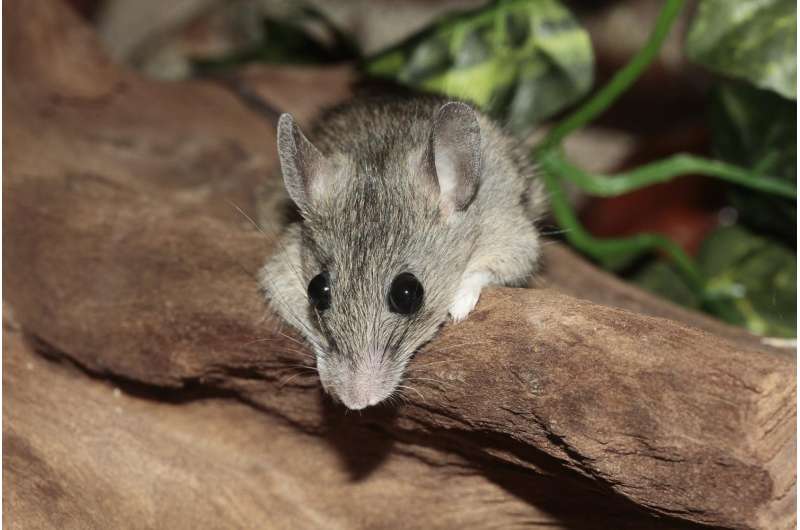Study identifies factor in 'young blood' that helps rejuvenate aged mouse muscle

As we age, our muscles gradually become smaller, weaker and less able to heal after injury. In a new study, UPMC and University of Pittsburgh researchers pinpoint an important mediator of youthfulness in mouse muscle, a discovery that could advance muscle regeneration therapies for older people.
Published today in Nature Aging, the study demonstrates that circulating shuttles called extracellular vesicles, or EVs, deliver genetic instructions for the longevity protein known as Klotho to muscle cells. Loss of muscle function and impaired muscle repair in old mice may be driven by aged EVs, which carry fewer copies of these instructions than those in young animals.
The findings are an important advance in understanding why the capacity for muscles to regenerate dwindles with age.
"We're really excited about this research for a couple of reasons," said senior author Fabrisia Ambrosio, Ph.D., director of rehabilitation for UPMC International and associate professor of physical medicine and rehabilitation at Pitt. "In one way, it helps us understand the basic biology of how muscle regeneration works and how it fails to work as we age. Then, taking that information to the next step, we can think about using extracellular vesicles as therapeutics to counteract these age-related defects."
The new study builds on decades of research showing that when old mice are given blood from young mice, youthful features are restored to many cells and tissues. But until now, it was unclear which components of young blood confer these rejuvenating effects.
"We wondered if extracellular vesicles might contribute to muscle regeneration because these couriers travel between cells via the blood and other bodily fluids," said lead author Amrita Sahu, Ph.D., postdoctoral fellow in the Department of Physical Medicine and Rehabilitation at Pitt. "Like a message in a bottle, EVs deliver information to target cells."
Ambrosio and her team collected serum, the fraction of blood that remains after removing blood cells and clotting factors, from young mice and injected it into aged mice with injured muscle. Mice that received young serum showed enhanced muscle regeneration and functional recovery compared to those that received a placebo treatment, but the serum's restorative properties were lost when EVs were removed, indicating that these vesicles mediate the beneficial effects of young blood.
Delving deeper, the researchers found that EVs deliver genetic instructions, or mRNA, encoding the anti-aging protein Klotho to muscle progenitor cells, a type of stem cell that is important for regeneration of skeletal muscle. EVs collected from old mice carried fewer copies of the instructions for Klotho than those from young mice, prompting muscle progenitor cells to produce less of this protein.
With increasing age, muscle doesn't heal as well after damage because scar tissue is deposited instead of restoring original muscle structure. In earlier work, Ambrosio and her team showed that Klotho is an important regulator of regenerative capacity in muscle progenitor cells and that this protein declines with age.
The new study shows for the first time that age-related shifts in EV cargo contribute to depleted Klotho in aged stem cells, suggesting that EVs could be developed into novel therapies for healing damaged muscle tissue.
"EVs may be beneficial for boosting regenerative capacity of muscle in older individuals and improving functional recovery after an injury," said Ambrosio, who is also a member of Pitt's McGowan Institute for Regenerative Medicine. "One of the ideas we're really excited about is engineering EVs with specific cargoes, so that we can dictate the responses of target cells."
Beyond muscles, EVs could also help reverse other effects of aging. Previous work has demonstrated that young blood can boost cognitive performance of aged mice. Ambrosio and coauthor Radosveta Koldamova, M.D., Ph.D., professor of environmental and occupational health at Pitt's Graduate School of Public Health, have a grant to explore the potential of EVs for reversing age-related declines in cognition.
Other researchers on the study were Zachary J. Clemens, Sunita N. Shinde, Sruthi Sivakumar, Abish Pius, Bennett Van Houten, Ph.D., Mita Lovalekar, Ph.D., Nicholas F. Fitz, Ph.D., Iliya Lefterov, M.D., Ph.D., and Aaron Barchowsky, Ph.D., all of Pitt; Ankit Bhatia of Carnegie Mellon University; and Silvia Picciolini, Ph.D., Cristiano Carlomagno, Ph.D., Alice Gualerzi, Ph.D., and Marzia Bedoni, Ph.D., all of IRCCS Fondazione Don Carlo Gnocchi.
More information: Fabrisia Ambrosio, Regulation of aged skeletal muscle regeneration by circulating extracellular vesicles, Nature Aging (2021). DOI: 10.1038/s43587-021-00143-2. www.nature.com/articles/s43587-021-00143-2




















